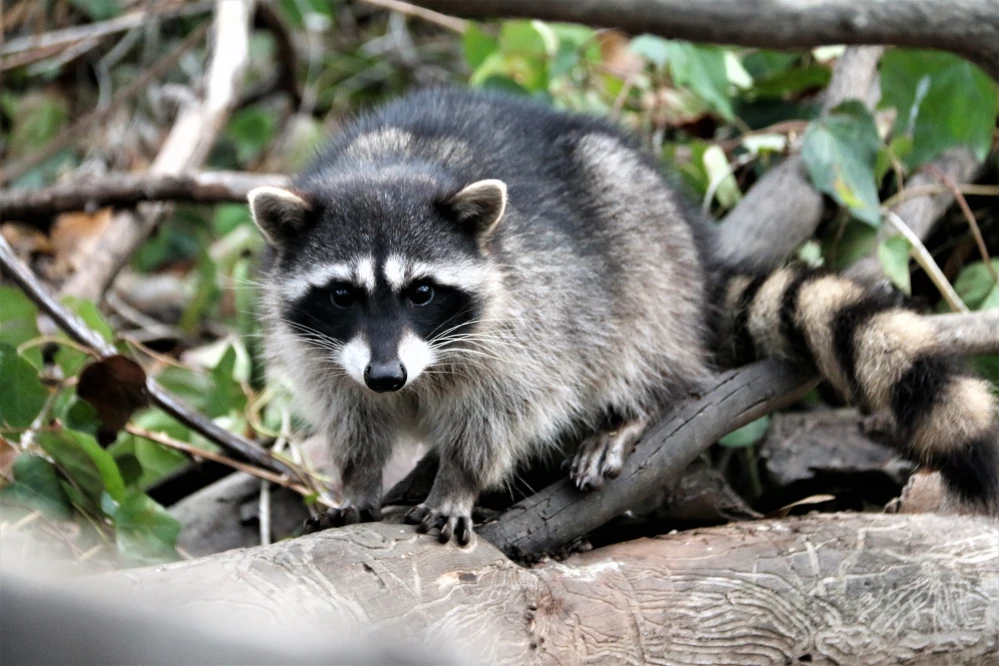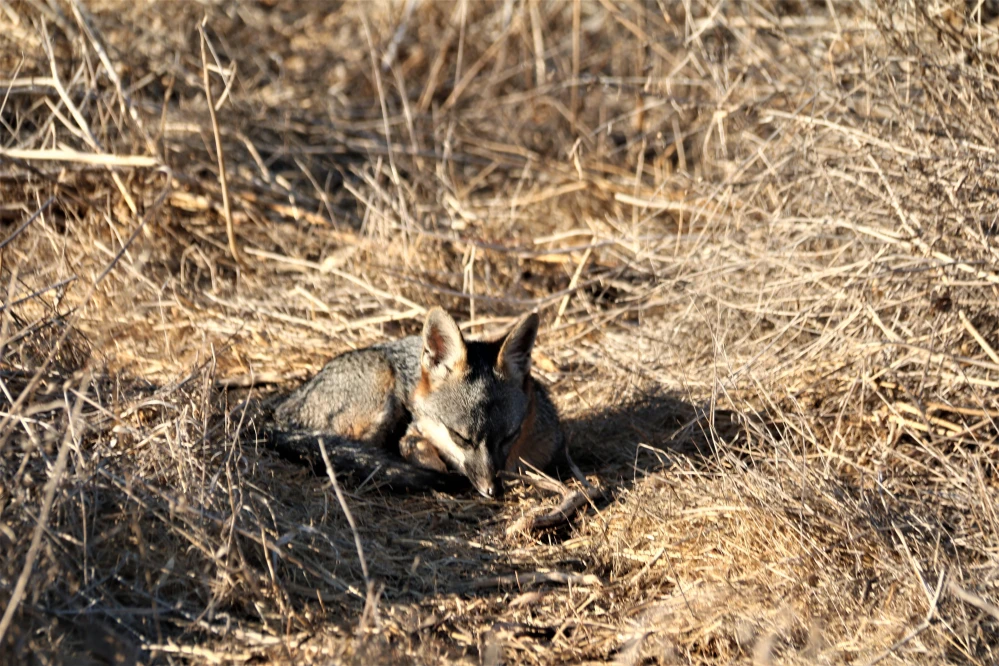A Raccoon Called Pesky and the Gray Foxes
by William C. Leikam
President, CEO & Co-founder, Urban Wildlife Research Project

As far back as October there has been an unusual young raccoon that may have left her mother and siblings long before she learned some of the finer emotional rules-of-the-road like restraint, like skittishness, and like knowing how to relate or not relate to other critters and including myself in the environment. Several days ago, I entered this into my Gray Fox Log, “Down in the clearing, neither of the foxes showed up but Pesky was there, following me everywhere I went. I do not understand that little raccoon. Why does a wild animal like that just one day show up with no fear, not skittish at all and begin to take over the territory?”
Most usually, the wildlife out there along the overflow channel respect each other by keeping an adequate distance between themselves. It’s as if they know that the area is limited and so they share what room there is. That’s true of even the foxes who are hugely territorial under normal circumstances. An example of that occurred one December morning after a nice rain, when Big Eyes encountered the big feral cat Blackie. Big Eyes cautiously approached Blackie, sniffed as she identified this cat just as Blackie raised her shoulders. Big Eyes slowly turned and slowly walked past the trail camera leaving Blackie to shake the rainwater from off his paws before walking away.

Early one morning in mid-December I stepped down into the concrete portion of the channel. I was startled for the foxes were right there before me. Usually, they are down the channel near Channel marker #22 or #23. They ran off for the brush. I kept my light on them. I didn’t notice that Pesky was down by the water in the creek. I had never seen her at that end of the channel. She came up to where the foxes were. At first Laimos and Big Eyes kept their distance, but as they grew more comfortable with the scene, Laimos approached Pesky and circled her, sniffing as he went. Big Eyes sat at the edge of the brush watching.
I walked on. They did not at first follow but when I emerged from Ditch Trail, they were over on the other side of the ditch. I didn’t see Pesky. I crossed the ditch and approached the foxes. Big Eyes jumped up onto the retaining wall. Laimos trotted ahead near camera #4. I turned and looked back to see if Pesky was nearby. That’s when I saw her across the ditch with three other raccoons. Pesky came across the ditch, stopped, and looked back at the others. The three other raccoons did not come right away, but within a minute there were four raccoons and two gray foxes all milling about keeping safe distances from each other. Pesky and two of the other raccoons got up onto the retaining wall.
The collaring project needs in excess of $35,000 and here’s the reason why you should consider a donation to UWRP be it $1 or $5,000 so that we can begin the collaring project dedicated to making the baylands along the San Francisco Bay a healthy place for wildlife to live. You can donate through PayPal or Give Direct, our preferred portal for giving. On our website (Urban Wildlife Research Project), check out the short video and go to the donate button nearby. Your donation is tax deductible.
Check out our Facebook page.
Check out Bill’s interview of January 1, 2021 hosted by the Town of Woodside California for their First Friday event at https://youtu.be/QrZzvmrqKTA
Bill will be doing an online show, a how to draw workshop featuring the gray fox with the renowned artist John Muir Laws on January 14, 2021. It will air from noon until 1:00 or 1:30 PM. https://johnmuirlaws.com/
You can access Bill’s PowerPoint presentation Corridors & Connections: Sustaining the Health of All Wildlife presented during the October 24th P-22 Urban Wildlife Festival here: https://www.youtube.com/watch?v=Dh4MQL1D1Cc
Section III
Gray Fox, Baylands Goals
Within the permit that allows the Urban Wildlife Research Project to conduct its study of the behavior of the gray fox at the Palo Alto Baylands Nature Preserve, the objectives covered area:
- Monitoring of urban gray fox Denning sites in Palo Alto Baylands.
This is being accomplished during the period when the gray foxes use a den site. It is one of the prime locations for gathering most of the behavioral data of the litter and for adults alike.
- Assessment of status and population trends of Baylands urban gray foxes
Since January 2019 a pair of resident gray foxes have claimed territory at the Palo Alto Baylands Nature Preserve.
- Identification of habitat features that promote the presence of urban gray foxes
After considering this and talking with people who know how to restore habitats, we need to assess what kinds of plants, including the Alkaline Salt Bush, would grow best along the edge of the saltwater channel and alongside the marsh. We need to grow a permanent habitat that contains the corridors and plant it as soon as possible. We’ll keep an eye on this as this is a critical link between the southern region of the Baylands and the northern region.
- Assessment of reproductive success and identification of factors that promote successful reproduction
Open up the pinch-point along Matadero Creek by developing thickets that link one area to another, instead of the present “islands”.
- Identification and assessment of possible dispersal travel routes.
Presently there can only be guesses as to dispersal travel routes. We intend to make this important question much more concrete when we attain our collaring/take/capture permit from the Department of Fish & Wildlife.




